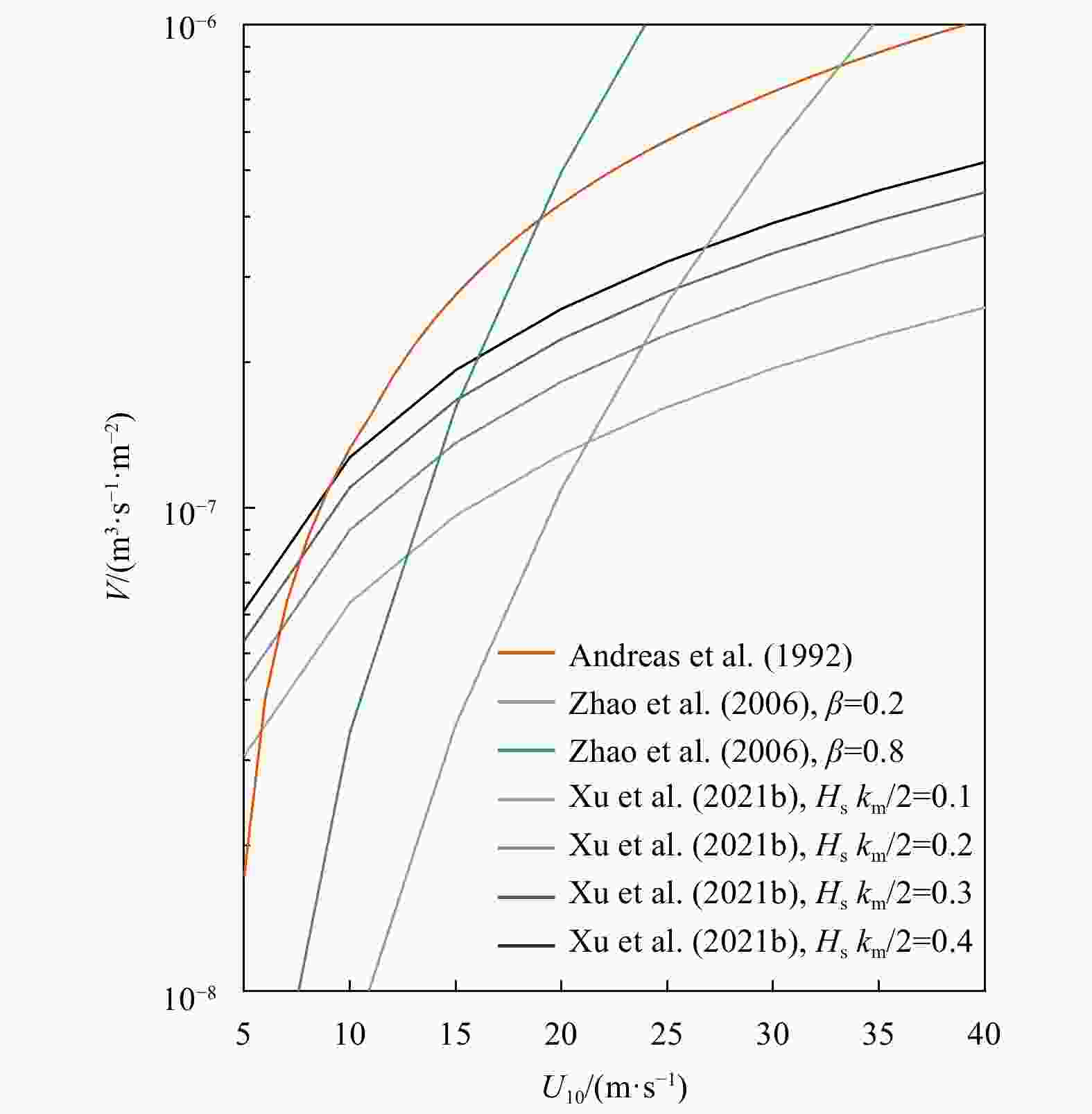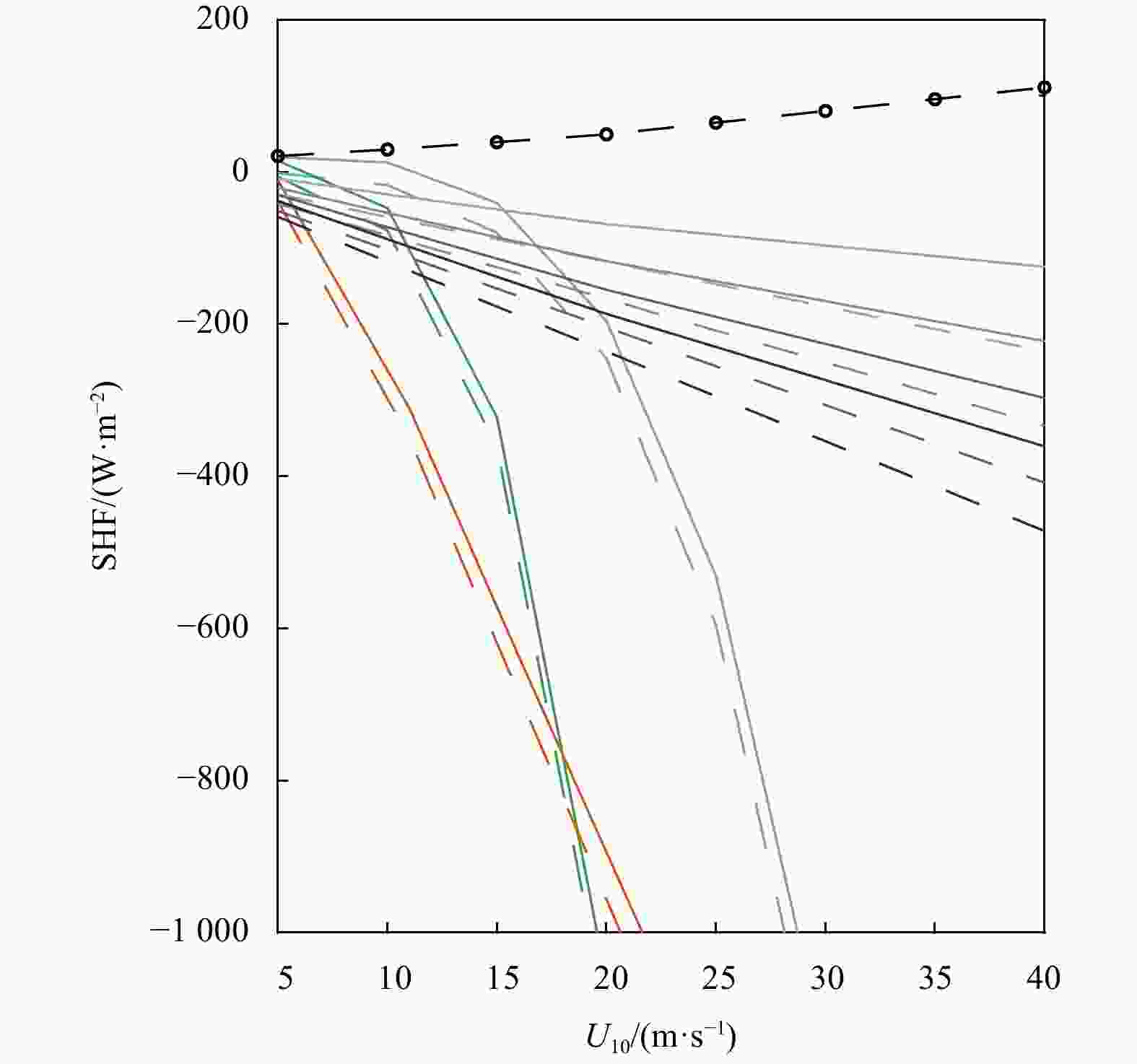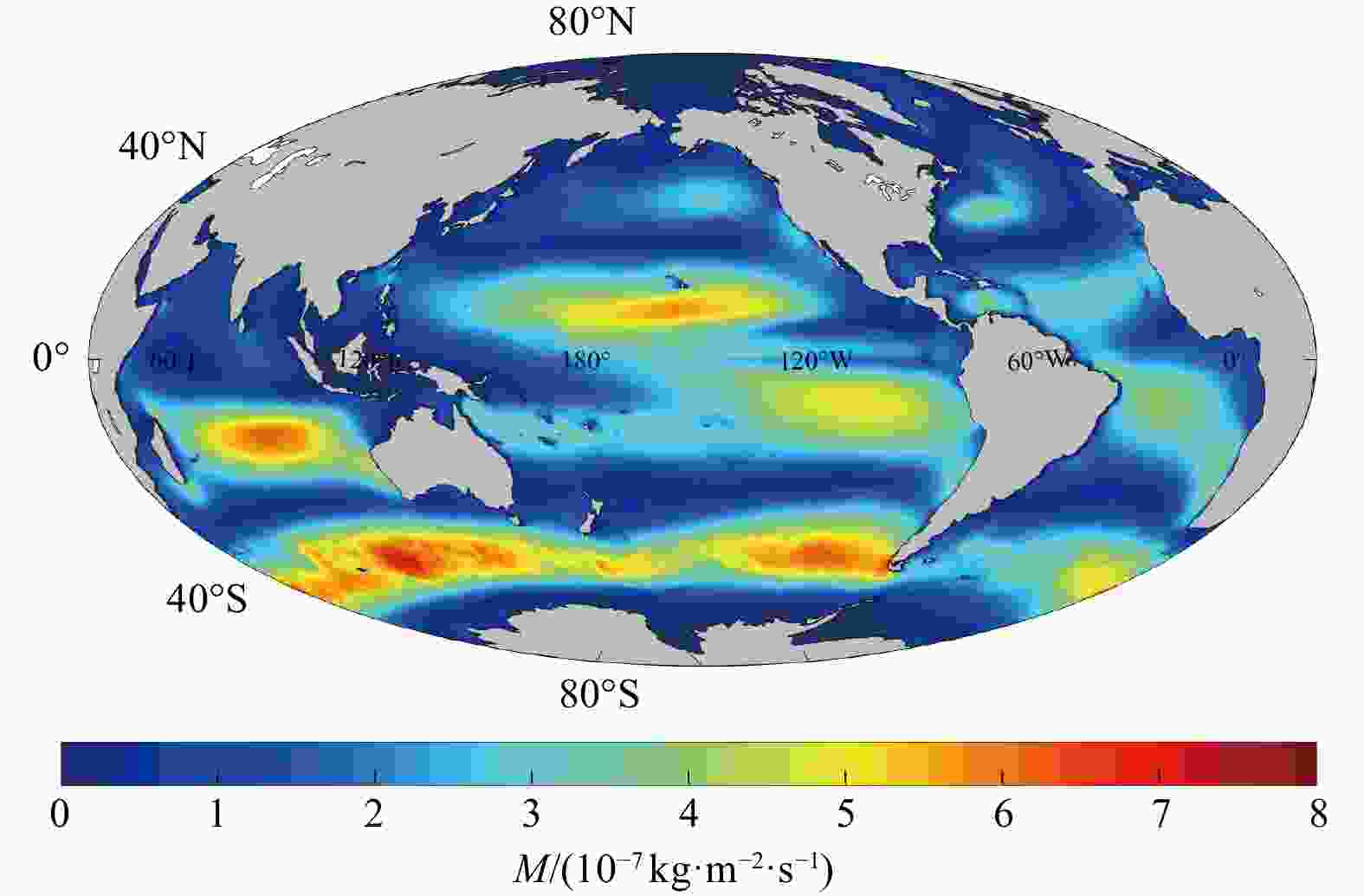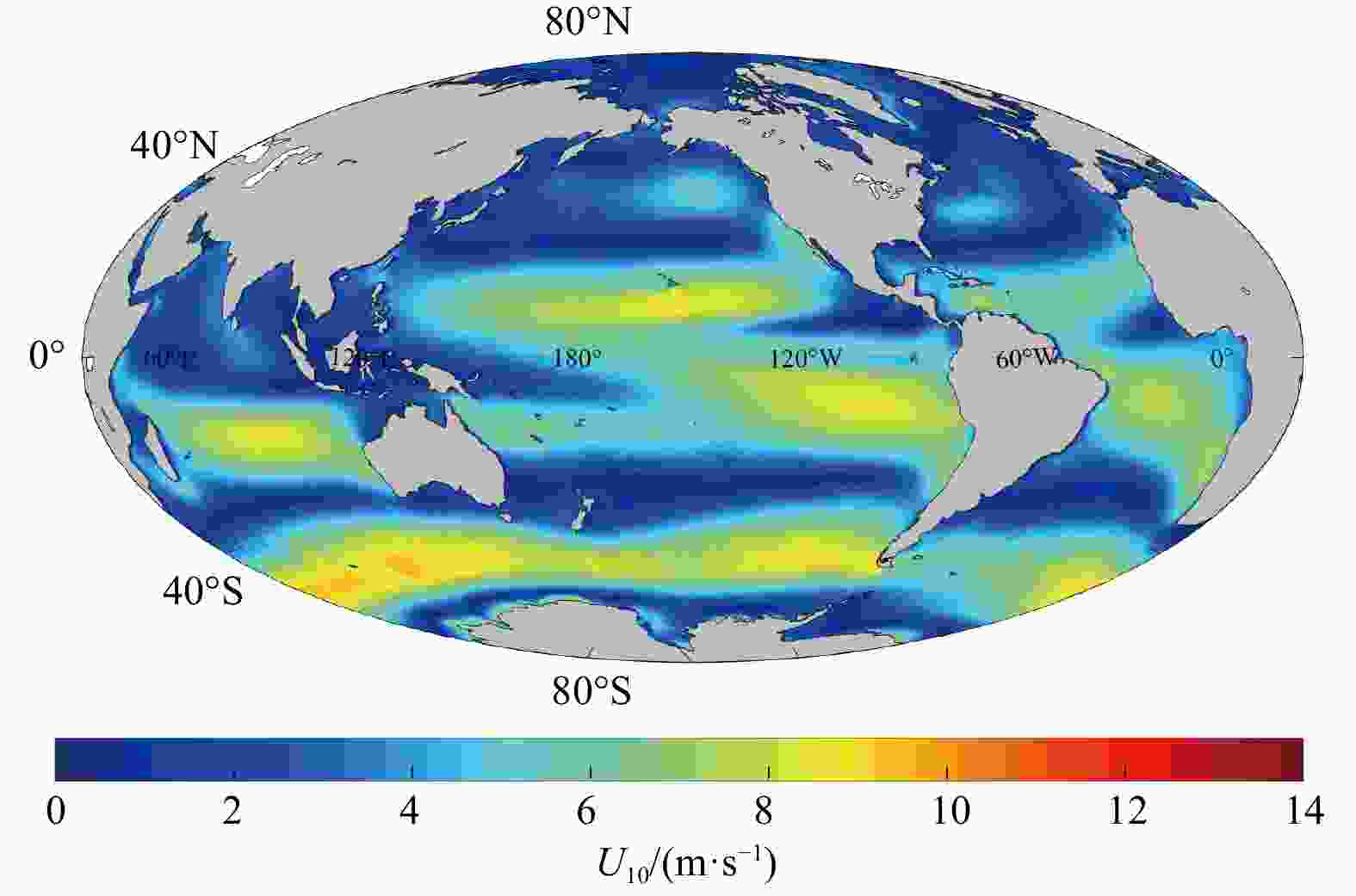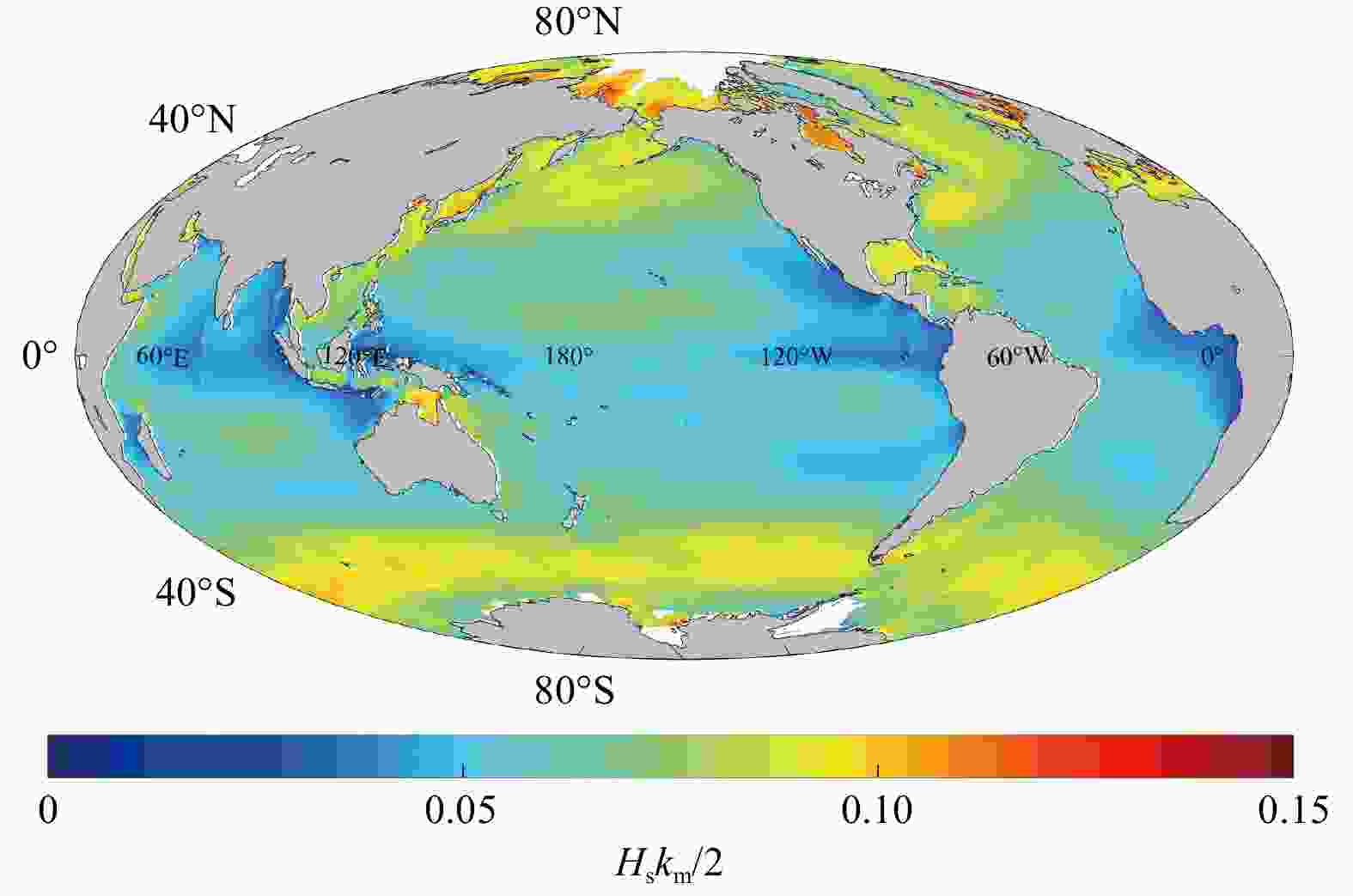Sea spray induced air-sea heat and salt fluxes based on the wave-steepness-dependent sea spray model
-
Abstract: Sea spray, which comprises amounts of small ocean droplets, plays a significant role in the air-sea coupling, atmospheric and oceanic dynamics, and climate. However, it remains arduous to arrive at estimates for the efficiency and accuracy of the sea spray induced air-sea heat and salt fluxes. This is because the microphysical process of sea spray evolution in the air is of extreme complexity. In this study, we iteratively calculated the sea spray induced air-sea heat and salt fluxes at various weather condition. To do so, we implemented one novel wave-steepness-dependent sea spray model into a bulk air-sea fluxes algorithm and utilized other sea spray models as comparisons. Based on the improved wave-dependent bulk turbulent algorithm, we observed that despite the negative contribution of sea spray to the sensible heat fluxes, the sea spray positively contributes to the air-sea latent heat fluxes, leading to an overall increase in the total air-sea heat fluxes. The additional heat fluxes caused by sea spray may be the missing critical process that can clarify the discrepancies observed between measured and modelled Tropical Cyclone’s development and intensification. In addition to heat fluxes, we observed that sea spray has significant impacts on the air-sea salt fluxes. As the sea salt particles are one of the main sources of the atmosphere aerosol, our results imply that sea spray could impact global and regional climate. Thus, given the significance of sea spray on the air-sea boundary layer, sea spray effects need to be considered in studies of air-sea interaction, dynamics of atmosphere and ocean.
-
Key words:
- sea spray /
- air-sea heat fluxes /
- air-sea salt fluxes /
- wave
-
Figure 2. Sea spray volume fluxes against the 10-m reference height wind speed
$ {U}_{10} $ .The solid black lines are the sea spray volume fluxes based on Xu et al. (2021b) for different values of the mean wave steepness (i.e.,$ {H}_{\rm{s}}{k}_{{\rm{m}}}/2 $ varies from 0.1 to 0.4 with an increment of 0.1), the solid red line is based on Andreas (1992), and the solod green lines are based on (Zhao et al., 2006) for different values of the wave age ($ \ \beta $ ) (i.e.,$ \ \beta = 0.2 $ and 0.4, respectively).Figure 3. The air-sea sensible heat fluxes (SHF) against the 10-m reference height wind speed
$ {U}_{10} $ . The sea spray induced sensible heat fluxes,$ {H}_{{\rm{s,sp}}} $ , is based on Xu et al. (2021b) (the dashed black lines with same gray value as in Fig. 2), Andreas (1992) (the dashed red line), and Zhao et al. (2006) (the dashed green lines with same color value as in Fig. 2), respectively. The interfacial direct sensible heat fluxes without sea spray,$ {H}_{{\rm{s,int}}} $ , is the dash black line with circle marks, and the air-sea sensible heat fluxes with sea spray,$ {H}_{{\rm{s,tot}}} $ , are the solid black, red, and green lines for Xu et al. (2021b), Andreas (1992), and Zhao et al. (2006), respectively (please see the legend in Fig. 2).Figure 4. The air-sea latent heat fluxes (LHF) against the 10-m reference height wind speed
$ {U}_{10} $ . The sea spray induced latent heat fluxes,$ {H}_{{\rm{l,sp}}} $ , is based on Xu et al. (2021b) (the dashed black lines with same gray value as in Fig. 2), Andreas (1992) (the dashed red line), and (Zhao et al., 2006) (the dashed green lines with same color value as in Fig. 2), respectively. The interfacial direct latent heat fluxes without sea spray,$ {H}_{{\rm{l,int}}} $ , is the dash black line with circle marks, and the air-sea latent heat fluxes with sea spray,$ {H}_{{\rm{l,tot}}} $ , are the solid black, red, and green lines for Xu et al. (2021b), Andreas (1992), and Zhao et al. (2006), respectively (please see the legend in Fig. 2).Figure 5. The total air-sea heat fluxes (SHF+LHF) against the 10-m reference height wind speed
$ {U}_{10} $ . The sea spray induced heat fluxes,$ {H}_{{\rm{l,sp}}}+{H}_{{\rm{s,sp}}} $ , is based on Xu et al. (2021b) (the dashed black lines with same gray value as in Fig. 2) , Andreas (1992) (the dashed red line), and (Zhao et al., 2006) (the dashed green lines with same color value as in Fig. 2), respectively. The interfacial direct air-sea total heat fluxes without sea spray,$ {H}_{{\rm{l,int}}}+{H}_{{\rm{s,int}}} $ , are the dash black line with circle marks, and the air-sea total heat fluxes with sea spray,$ {H}_{{\rm{l,tot}}}+{H}_{{\rm{s,tot}}} $ , are the solid black, red, and green lines for Xu et al. (2021b), Andreas (1992), and Zhao et al. (2006), respectively (please see the legend in Fig. 2).Figure 6. The sea spray induced salt fluxes (M) against the 10-m reference height wind speed
$ {U}_{10} $ . The black lines are the sea spray induced salt fluxes,$ {M}_{{\rm{s,sp}}} $ , based on Xu et al. (2021b) for different$ {H}_{\rm{s}}{k}_{{\rm{m}}}/2 $ which varies from 0.1 to 0.4 with an increment of 0.1 (gray value as in Fig. 2), Andreas (1992) (the red line), and (Zhao et al., 2006) (the green lines with same color value as in Fig. 2), respectively (please see the legend in Fig. 2). -
Andreae M O, Rosenfeld D. 2008. Aerosol–cloud–precipitation interactions. Part 1. The nature and sources of cloud-active aerosols. Earth-Science Reviews, 89(1–2): 13–41 Andreas E L. 1989. Thermal and size evolution of sea spray droplets. Hanover: Cold Regions Research and Engineering Lab Andreas E L. 1990. Time constants for the evolution of sea spray droplets. Tellus B: Chemical and Physical Meteorology, 42(5): 481–497. doi: 10.3402/tellusb.v42i5.15241 Andreas E L. 1992. Sea spray and the turbulent air-sea heat fluxes. Journal of Geophysical Research: Oceans, 97(C7): 11429–11441. doi: 10.1029/92JC00876 Andreas E L. 1995. The temperature of evaporating sea spray droplets. Journal of the Atmospheric Sciences, 52(7): 852–862. doi: 10.1175/1520-0469(1995)052<0852:TTOESS>2.0.CO;2 Andreas E L. 1998. A new sea spray generation function for wind speeds up to 32 m s−1. Journal of Physical Oceanography, 28(11): 2175–2184. doi: 10.1175/1520-0485(1998)028<2175:ANSSGF>2.0.CO;2 Andreas E L. 2010. Spray-mediated enthalpy flux to the atmosphere and salt flux to the ocean in high winds. Journal of Physical Oceanography, 40(3): 608–619. doi: 10.1175/2009JPO4232.1 Andreas E L, Decosmo J. 1999. Sea spray production and influence on air-sea heat and moisture fluxes over the open ocean. In: Geernaert G L, ed. Air-Sea Exchange: Physics, Chemistry and Dynamics. Dordrecht: Springer, 327–362 Andreas E L, Decosmo J. 2002. The signature of sea spray in the hexos turbulent heat flux data. Boundary-Layer Meteorology, 103(2): 303–333. doi: 10.1023/A:1014564513650 Andreas E L, Emanuel K A. 2001. Effects of sea spray on tropical cyclone intensity. Journal of the Atmospheric Sciences, 58(24): 3741–3751. doi: 10.1175/1520-0469(2001)058<3741:EOSSOT>2.0.CO;2 Andreas E L, Mahrt L, Vickers D. 2015. An improved bulk air–sea surface flux algorithm, including spray-mediated transfer. Quarterly Journal of the Royal Meteorological Society, 141(687): 642–654. doi: 10.1002/qj.2424 Andreas E L, Persson P O G, Hare J E. 2008. A bulk turbulent air–sea flux algorithm for high-wind, spray conditions. Journal of Physical Oceanography, 38(7): 1581–1596. doi: 10.1175/2007JPO3813.1 Bao J W, Fairall C W, Michelson S A, et al. 2011. Parameterizations of sea-spray impact on the air–sea momentum and heat fluxes. Monthly Weather Review, 139(12): 3781–3797. doi: 10.1175/MWR-D-11-00007.1 Chan J C L. 2005. The physics of tropical cyclone motion. Annual Review of Fluid Mechanics, 37: 99–128. doi: 10.1146/annurev.fluid.37.061903.175702 Collins III C O, Potter H, Lund B, et al. 2018. Directional wave spectra observed during intense tropical cyclones. Journal of Geophysical Research: Oceans, 123(2): 773–793. doi: 10.1002/2017JC012943 Emanuel K A. 1995. Sensitivity of tropical cyclones to surface exchange coefficients and a revised steady-state model incorporating eye dynamics. Journal of the Atmospheric Sciences, 52(22): 3969–3976. doi: 10.1175/1520-0469(1995)052<3969:SOTCTS>2.0.CO;2 Emanuel K. 2003. Tropical cyclones. Annual Review of Earth and Planetary Sciences, 31: 75–104. doi: 10.1146/annurev.earth.31.100901.141259 Emanuel K. 2005. Increasing destructiveness of tropical cyclones over the past 30 years. Nature, 436(7051): 686–688. doi: 10.1038/nature03906 Fairall C W, Bradley E F, Rogers D P, et al. 1996. Bulk parameterization of air-sea fluxes for tropical ocean-global atmosphere coupled-ocean atmosphere response experiment. Journal of Geophysical Research: Oceans, 101(C2): 3747–3764. doi: 10.1029/95JC03205 Fairall C W, Yang Mingxi, Bariteau L, et al. 2011. Implementation of the coupled ocean-atmosphere response experiment flux algorithm with CO2, dimethyl sulfide, and O3. Journal of Geophysical Research: Oceans, 116(C4): C00F09 Gall J S, Frank W M, Kwon Y. 2008. Effects of sea spray on tropical cyclones simulated under idealized conditions. Monthly Weather Review, 136(5): 1686–1705. doi: 10.1175/2007MWR2183.1 Garg N, Ng E Y K, Narasimalu S. 2018. The effects of sea spray and atmosphere–wave coupling on air–sea exchange during a tropical cyclone. Atmospheric Chemistry and Physics, 18(8): 6001–6021. doi: 10.5194/acp-18-6001-2018 Jarosz E, Mitchell D A, Wang D W, et al. 2007. Bottom-up determination of air-sea momentum exchange under a major tropical cyclone. Science, 315(5819): 1707–1709. doi: 10.1126/science.1136466 Kanakidou M, Seinfeld J H, Pandis S N, et al. 2005. Organic aerosol and global climate modelling: a review. Atmospheric Chemistry and Physics, 5(4): 1053–1123. doi: 10.5194/acp-5-1053-2005 Liu Bin, Guan Changlong, Xie Li’an, et al. 2012. An investigation of the effects of wave state and sea spray on an idealized typhoon using an air-sea coupled modeling system. Advances in Atmospheric Sciences, 29(2): 391–406. doi: 10.1007/s00376-011-1059-7 Liu Bin, Liu Huiqing, Xie Lian, et al. 2011. A coupled atmosphere–wave–ocean modeling system: simulation of the intensity of an idealized tropical cyclone. Monthly Weather Review, 139(1): 132–152. doi: 10.1175/2010MWR3396.1 Ma Hongyu, Babanin A V, Qiao Fangli. 2020. Field observations of sea spray under tropical cyclone olwyn. Ocean Dynamics, 70(11): 1439–1448. doi: 10.1007/s10236-020-01408-x Montgomery M T, Farrell B F. 1993. Tropical cyclone formation. Journal of the Atmospheric Sciences, 50(2): 285–310. doi: 10.1175/1520-0469(1993)050<0285:TCF>2.0.CO;2 Pandis S N, Harley R A, Cass G R, et al. 1992. Secondary organic aerosol formation and transport. Atmospheric Environment. Part A. General Topics, 26(13): 2269–2282 Pandis S N, Seinfeld J H. 1989. Sensitivity analysis of a chemical mechanism for aqueous-phase atmospheric chemistry. Journal of Geophysical Research: Atmospheres, 94(D1): 1105–1126. doi: 10.1029/JD094iD01p01105 Powell M D, Vickery P J, Reinhold T A. 2003. Reduced drag coefficient for high wind speeds in tropical cyclones. Nature, 422(6929): 279–283. doi: 10.1038/nature01481 Pruppacher H R, Klett J D. 1978. Microstructure of atmospheric clouds and precipitation. In: Pruppacher H R, Klett J D, eds. Microphysics of Clouds and Precipitation. Dordrecht: Springer, 9–55 Rastigejev Y, Suslov S A. 2022. Investigation of sea spray effect on the vertical momentum transport using an eulerian multifluid-type model. Journal of Physical Oceanography, 52(1): 99–117. doi: 10.1175/JPO-D-21-0127.1 Riehl H. 1948. On the formation of typhoons. Journal of the Atmospheric Sciences, 5(6): 247–265 Seinfeld J, Pandis S. 2008. Atmospheric Chemistry and Physics. New York: John Wiley&Sons Inc. Soloviev A V, Lukas R, Donelan M A, et al. 2014. The air-sea interface and surface stress under tropical cyclones. Scientific Reports, 4: 5306. doi: 10.1038/srep05306 Sroka S, Emanuel K. 2021. A review of parameterizations for enthalpy and momentum fluxes from sea spray in tropical cyclones. Journal of Physical Oceanography, 51(10): 3053–3069 Sroka S, Emanuel K. 2022. Sensitivity of sea-surface enthalpy and momentum fluxes to sea spray microphysics. Journal of Geophysical Research: Oceans, 127(1): e2021JC017774 Syrett B C. 1976. Erosion-corrosion of copper-nickel alloys in sea water and other aqueous environments—a literature review. Corrosion, 32(6): 242–252. doi: 10.5006/0010-9312-32.6.242 Taylor P K, Yelland M J. 2001. The dependence of sea surface roughness on the height and steepness of the waves. Journal of Physical Oceanography, 31(2): 572–590. doi: 10.1175/1520-0485(2001)031<0572:TDOSSR>2.0.CO;2 Textor C, Schulz M, Guibert S, et al. 2006. Analysis and quantification of the diversities of aerosol life cycles within aerocom. Atmospheric Chemistry and Physics, 6(7): 1777–1813. doi: 10.5194/acp-6-1777-2006 Veron F. 2015. Ocean spray. Annual Review of Fluid Mechanics, 47: 507–538. doi: 10.1146/annurev-fluid-010814-014651 Voermans J J, Rapizo H, Ma Hongyu, et al. 2019. Air–sea momentum fluxes during tropical cyclone olwyn. Journal of Physical Oceanography, 49(6): 1369–1379. doi: 10.1175/JPO-D-18-0261.1 Webster P J, Holland G J, Curry J A, et al. 2005. Changes in tropical cyclone number, duration, and intensity in a warming environment. Science, 309(5742): 1844–1846. doi: 10.1126/science.1116448 Wu Jin. 1974. Evaporation due to spray. Journal of Geophysical Research, 79(27): 4107–4109. doi: 10.1029/JC079i027p04107 Xu Xingkun, Voermans J J, Liu Qingxiang, et al. 2021a. Impacts of the wave-dependent sea spray parameterizations on air–sea–wave coupled modeling under an idealized tropical cyclone. Journal of Marine Science and Engineering, 9(12): 1390. doi: 10.3390/jmse9121390 Xu Xingkun, Voermans J J, Ma Hongyu, et al. 2021b. A wind–wave-dependent sea spray volume flux model based on field experiments. Journal of Marine Science and Engineering, 9(11): 1168. doi: 10.3390/jmse9111168 Zhang Huai, Lou Shunli. 1995. Effects of spray on the momentum, heat and vapor transfers over the sea. I. Equations and initial values. Journal of Ocean University of Qingdao (in Chinese), 25(2): 131–138 Zhang Lianxin, Zhang Xuefeng, Chu P C, et al. 2017. Impact of sea spray on the Yellow and East China seas thermal structure during the passage of typhoon rammasun (2002). Journal of Geophysical Research: Oceans, 122(10): 7783–7802. doi: 10.1002/2016JC012592 Zhang Lianxin, Zhang Xuefeng, Perrie W, et al. 2021. Impact of sea spray and sea surface roughness on the upper ocean response to super typhoon haitang (2005). Journal of Physical Oceanography, 51(6): 1929–1945 Zhao Biao, Qiao Fangli, Cavaleri L, et al. 2017. Sensitivity of typhoon modeling to surface waves and rainfall. Journal of Geophysical Research: Oceans, 122(3): 1702–1723. doi: 10.1002/2016JC012262 Zhao Dongliang, Toba Y, Sugioka K I, et al. 2006. New sea spray generation function for spume droplets. Journal of Geophysical Research: Oceans, 111(C2): C02007 Zhou Zhigang, Li Haojia, Liu Xin, et al. 2020. Investigation of sea salt erosion effect on the asphalt-aggregate interfacial system. International Journal of Pavement Research and Technology, 13(2): 145–153. doi: 10.1007/s42947-019-0095-2 -




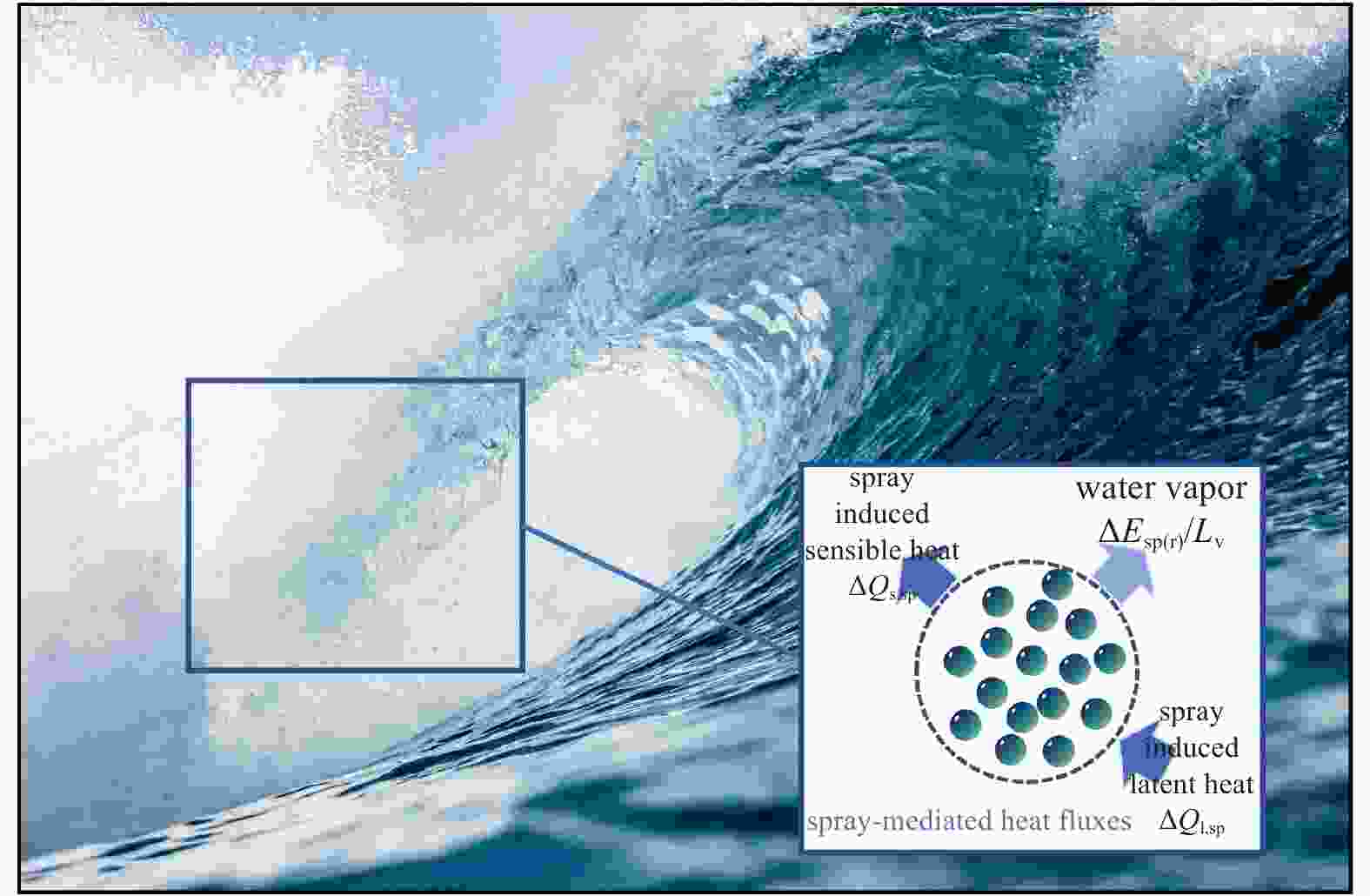
 下载:
下载:
